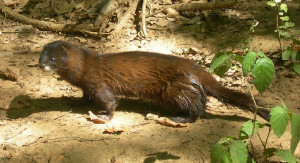 These animals are excellent swimmers and divers, and they possess a number of amphibiotic adaptations. In appearance, this mink is closer to the Siberian weasel and a ferret, with an even squattier body, flatter head, smaller ears, and thicker fur with undercoat even thicker. It is monotonic in coloration – dark black-brown, with more reddish in the European species. The latter also has a white spot on both lips. The American mink usually has the spot on the lower lip only. The European mink is notably smaller and weaker than the American. Its body is 32-43 cm long, with the length of tail of 12-19 cm, and mass of 550-800 gr. These two species also stand apart by certain peculiarities in the structure of teeth and skull.
These animals are excellent swimmers and divers, and they possess a number of amphibiotic adaptations. In appearance, this mink is closer to the Siberian weasel and a ferret, with an even squattier body, flatter head, smaller ears, and thicker fur with undercoat even thicker. It is monotonic in coloration – dark black-brown, with more reddish in the European species. The latter also has a white spot on both lips. The American mink usually has the spot on the lower lip only. The European mink is notably smaller and weaker than the American. Its body is 32-43 cm long, with the length of tail of 12-19 cm, and mass of 550-800 gr. These two species also stand apart by certain peculiarities in the structure of teeth and skull.
The areal of the European mink is patchy. It is extremely rare in the territory of the Pskov Region, having been driven out by the American mink.
Minks prefer streams with cluttered and caved in banks, where there are many reliable shelters in roots, hollows etc., with abundant water voles, water rats, smaller rodents, crawfish, fish, frogs etc. In the winter, minks stick to air holes or hide in ice and snow, surfacing rarely.
The European mink is often referred to as the Russian mink. In the past, it was numerous in European countries. Now it continues to inhabit Finland, the Leningrad, Pskov, Tver’ and Novgorod Regions, as well as Western Siberia.
It is red-listed in Russia and internationally.
/ * The photos at lake.peipsi.org are cross-posted from commons.wikimedia.org and are used for familiarization purposes only. No commercial use of the photos is allowed. For more information about to use the photos see the originals on commons.wikimedia.org. /


